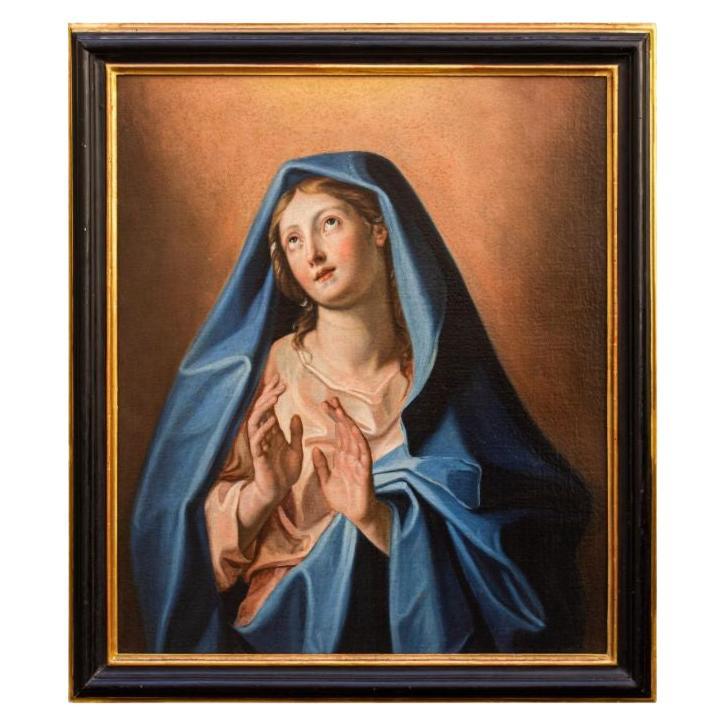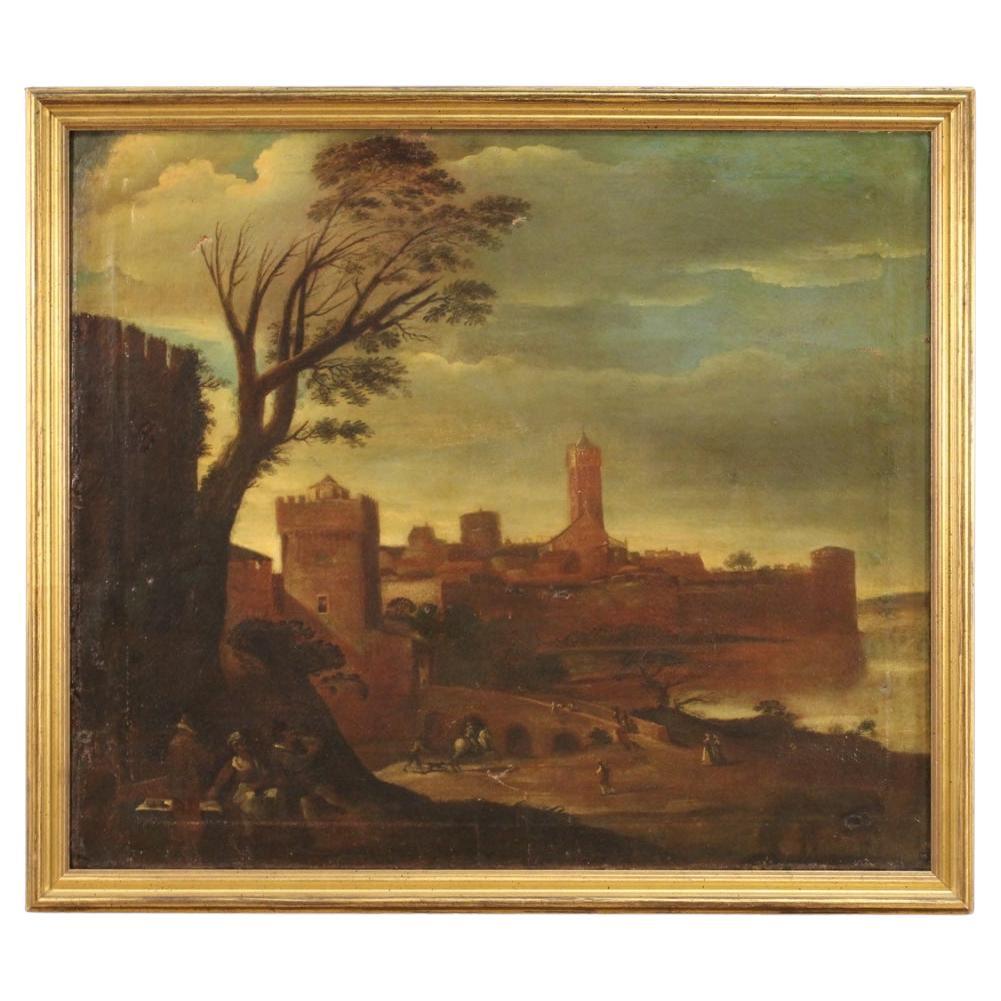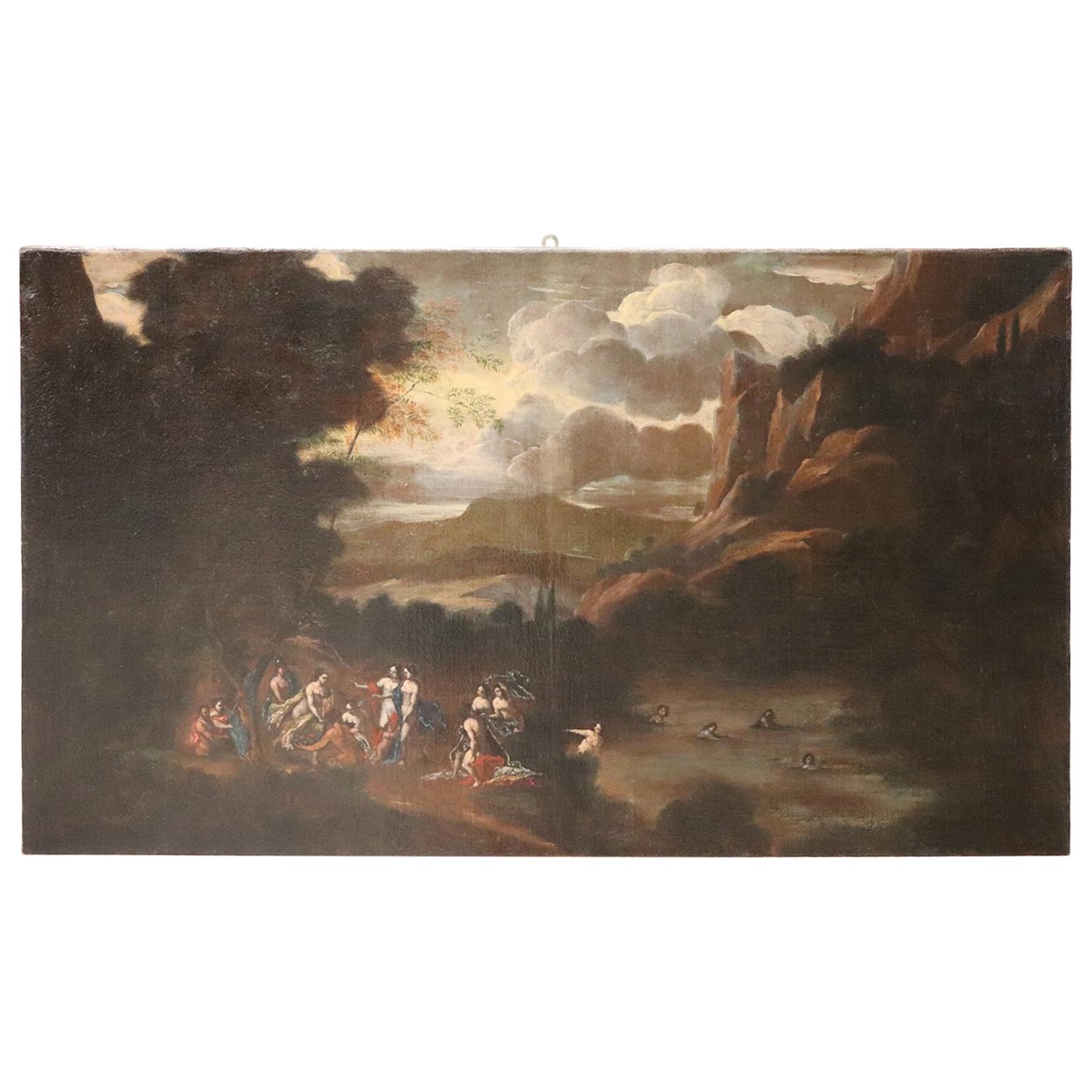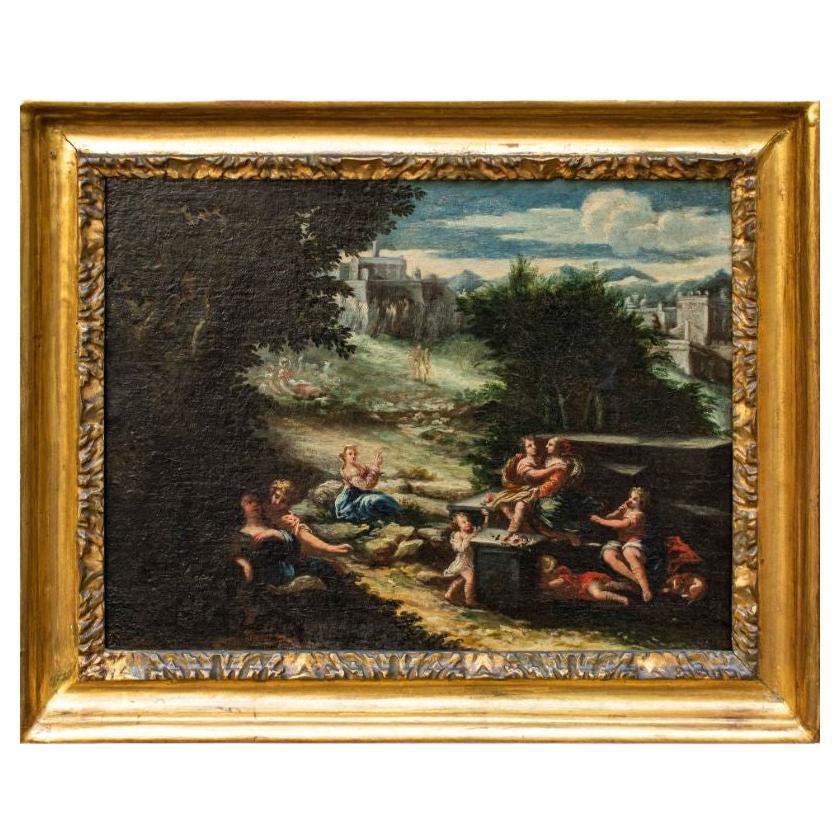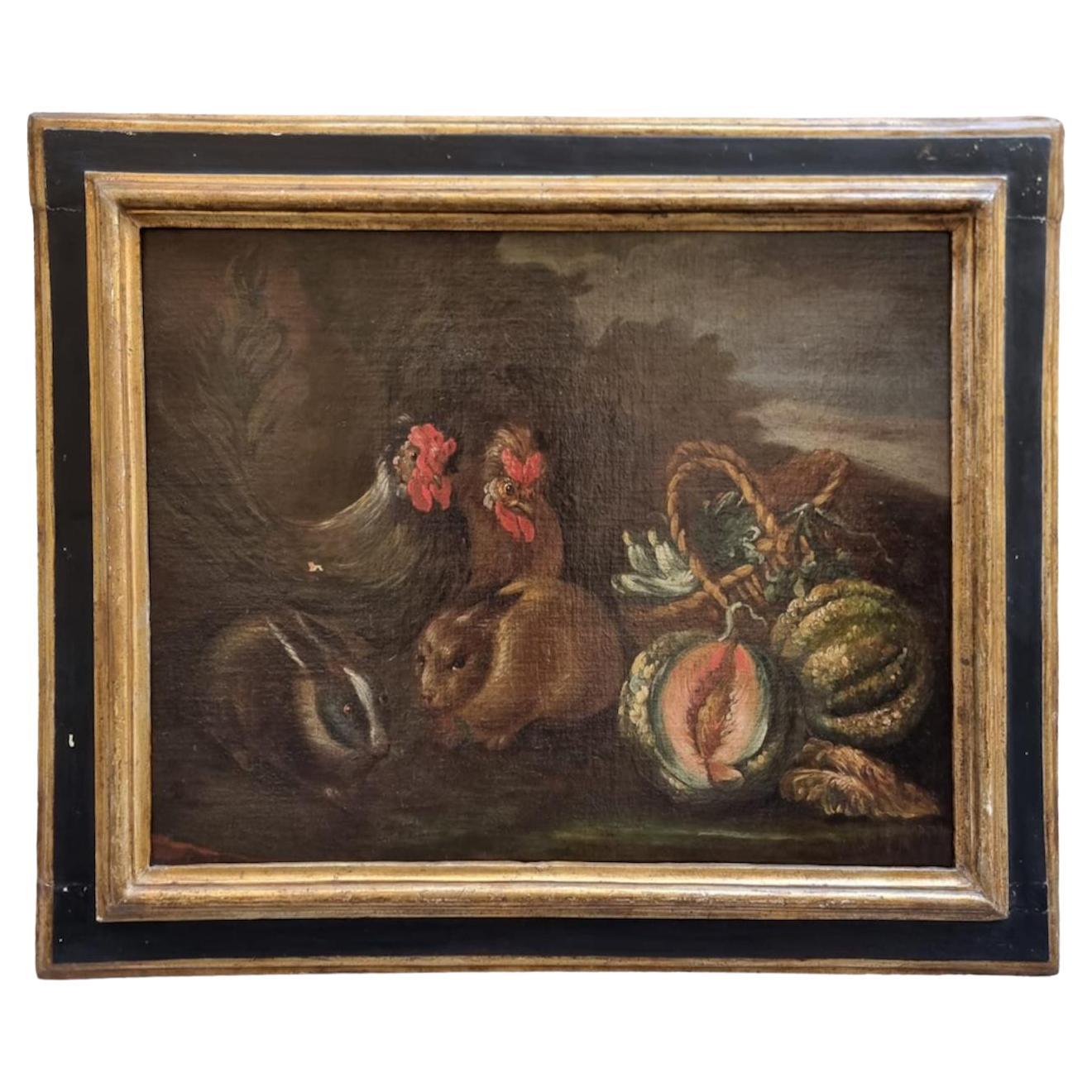Items Similar to 17th Century Roman Landscape Painting Oil on Canvas by Bloemen
Want more images or videos?
Request additional images or videos from the seller
1 of 6
17th Century Roman Landscape Painting Oil on Canvas by Bloemen
About the Item
Workshop of Jan Frans van Bloemen (Antwerp, 1622 - Rome, 1749)
Lazio landscape
Oil on canvas, 48.5 x 64.5 cm
The painting, to be considered belonging to the vast production of Jan Frans van Bloemen and his students, first of all Marcantonio Sardi, active in Rome between 1711 and 1733.
The composition portrays the luxuriant Roman countryside, in particular it is the village of Grottaferrata with the church and convent of Santa Maria and San Nino, following an image scheme well tested by the 18th century landscape architects active in the papal city and in particular from Bloemen, as the numerous comparisons of paintings now in national and international private collections clearly show (Florence, Bari, London and New York), in the three recurring figures, the washerwoman and the man and woman seated on ancient ruins in the foreground who address her casually, while in the background the perched village and the vast valley with pointed peaks open up.
He belonged to a family of Flemish painters and designers, also active in Italy and France. From 1686-1687 the two brothers, Jan and Pieter, lived in Rome, where they joined the Schildersbent, Pieter with the nickname of Banner, probably for the banners he painted in the battle scenes, while Jan Frans with the nickname of Orizzonte , for the ease with which he painted landscapes, previously given to Claude Lorrain. Jan no longer left Rome except for a short period of eight months, during which he visited Naples, Sicily and Malta, in 1714 he was included among the Virtuosi al Pantheon and collaborated with Placido Costanzi and Filippo Lauri. Among his patrons and collectors we remember the Pallavicini families (in whose gallery there are some paintings still today) and Rospigliosi, Luigi Bonaparte,
Orizzonte was fascinated by the beauty of Rome and its surroundings and inspired by the classic landscapes of Gaspard Dughet. Having as a basis the Flemish landscape tradition, he had no difficulty in assimilating Dughet's analytical realism and quickly becoming one of the best classical landscape painters in Rome in the first half of the 18th century [6] proceeding according to the Arcadian-Rococo style of the period. Van Bloemen's changing motifs of light and shadow are also characteristic of Dughet's work, so much so that Horizon's paintings were sometimes mistaken for Dughet's. Van Bloemen used other artists to complement his landscapes with figures. Among these were Carlo Maratta, Placido Costanzi, Pompeo Batoni and his brother Pieter.
- Dimensions:Height: 19.3 in (49 cm)Width: 25.99 in (66 cm)Depth: 1.19 in (3 cm)
- Materials and Techniques:
- Place of Origin:
- Period:Late 17th Century
- Date of Manufacture:17th Century
- Condition:Refinished. Wear consistent with age and use. The painting has been cleaned.
- Seller Location:Milan, IT
- Reference Number:1stDibs: LU5918226671422

About the Seller
5.0
Vetted Seller
These experienced sellers undergo a comprehensive evaluation by our team of in-house experts.
Established in 2000
1stDibs seller since 2021
25 sales on 1stDibs
Typical response time: 12 hours
- ShippingRetrieving quote...Ships From: Milan, Italy
- Return PolicyA return for this item may be initiated within 14 days of delivery.
More From This SellerView All
- Early 17th Century Roman School Praying Madonna Painting Oil on CanvasLocated in Milan, ITRoman school, late 16th-early 17th century Praying Madonna Oil on canvas, 81 x 69 cm Frame 83 x 95.5 cm A divine whiteness reverberates with vibrant luster on the maphorion of the present Virgin. The palpable iridescence that structures the thin rosaceous garment, woven with the same fresh light, produces a slight rustle when she takes her hands off. The Madonna in fact takes a prayerful pose, opening her palms to underline her fervent ecstatic intention; the white neck is rendered with perishable fullness of pigments, like the hands, perfectly alive, and the very shiny eyes. With fine shrewdness the artist of the present styles the Virgin's hair with thin white ribbons, exacerbating the purity. An evocative light falls gently on the bust, a materialized sign of divine glory. The present can be traced back to the late Mannerist climate that prevailed in the capital after the emanation of the Tridentine council (1545-1563). The late Mannerist licenses that can still be seen there, such as the intense lyricism in the stylistic code adopted by the artist, are innervated in the new basic catechetical intent, which at the end of the century produced a certain figurative rigorism. The present, however, still responds to that extraordinary Roman dynamism that raised the capital to a bulwark for the entire mannerist lesson, matched only by a second artistic center, the Florentine one. The engaging carriage of the Virgin reflects the contemporary examples of Giuseppe Valeriano (1542-1596), a Jesuit painter, returning in the Marriage of the Virgin of the Roman Church of Jesus, as well as in the Madonna of Sorrows in the Recanati Altarpiece, equal ardor. But it is in the Assumption of the Virgin painted in four hands with Scipione Pulzone...Category
Antique Early 17th Century Italian Paintings
MaterialsCanvas
- 17th Century Rural Landscape with Gallant Scenes Painting Oil on CanvasLocated in Milan, IT17th century, Emilian school Rural landscape with gallant scenes Oil on canvas, 37 x 47.5 cm With frame 61 x 50.5 cm The bucolic amenity of the present is reflected in the joyful gallant scenes that dot its surface. The locus amoenus described reflects on the more traditional inflection of Arcadia, which in the literary transfiguration was the scenario par excellence of the most carefree pastoral life and out of this world; the painting is therefore a forerunner of what was professed by the actual poetic academy of Arcadia which was established in Rome in 1690, but enthusiastically testifies to the feverish invitations to its acceptance, then widespread in the most avant-garde cultural salons throughout Italy. First Theocritus and Virgil later had awakened with Idilli and Bucoliche that capacity typical of the natural world to allow an escape from reality; the contemplation of perfect natural fruits that followed would have evoked in the spirits of dreaming men back to origins. The bucolic landscape was able to positively give a rhythm to material life, and constituted the concretization of a place devoid of incivility and ugliness, where only dreams, wild music and homages to fruitful nature were allowed. In the present painting widespread figures of shepherd children trace the same intent to the sublimation of earthly life, gathered in pairs, while children on the model of the ancient cherubs cheer the field with flowers and petals. The games of these and the sweet affections of the other characters are rendered through liquid and vibrant brushstrokes, flickering with a white light that opposes the dark shadow of the undergrowth. In the distance, the sky tapers with a silvery and flat brushstroke, while the vertical development of the promoters with architectures helps to introject a bright beam of light into the grassy clearing. The foliage and the turf of the landscape piece are rendered through a digital brushstroke, betraying the Italian brand of the present, influenced at the same time by the seventeenth-century European influences that then conveyed to the capital. The evocative culture of the city attracted many artists from the city of Bologna, from the Italian north but also from the territories beyond the Alps, such as Claude Lorrain and Nicolas Poussin. The historical-artistic heritage of the Italian pastoral scenes was thus able to fill up with the more functional and particular formalisms of the charms coming from elsewhere, such as the expressive tremor of the present, similar to the contemporary French lexicon. The typological restitution from pastoral idyll, in accordance with the intrinsic stylistic qualities of the work, allows us to specify the solid belonging of the present to the Italian hand, similarly to what was then emerging in the pictorial sphere within the Emilian school. In this regard, we should recall the latent influences of two decisive foreign landscape painters who passed through the Emilian belt, such as Claude Lorrain (1600-1682) and Nicolas Poussin (1594-1665); before them, Giovanni Battista Viola...Category
Antique 17th Century Italian Paintings
MaterialsCanvas
- Oil painting on canvas depicting Still life Roman school of the 17th centuryLocated in Milan, ITRoman School, 17th century Still Life Oil on canvas, 79 x 107 cm Framed, 93 x 121 cm The work under scrutiny, depicting a majestic still life of flowers, is ascribed to the 17th...Category
Antique 17th Century Paintings
MaterialsCanvas
- 17th Century Angelica and Medoro Painted Oil on Canvas Roman SchoolLocated in Milan, ITRoman School, 17th century Angelica and Medoro engrave their names on the bark of a tree Oil on canvas, 65 x 48.5 cm The canvas depicts one of the most famous episodes of O...Category
Antique 17th Century Italian Paintings
MaterialsCanvas
- 17th Century Christ and the Samaritan Oil on Canvas Roman SchoolLocated in Milan, ITRoman school of the 17th century Landscape with bridge - Christ and the Samaritan woman at the well Oil on canvas, cm 42 x 59,5 - With frame, cm 54, 5 x 71 cm The small canvas portrays a broad view of the city surrounded by a bucolic and lush landscape, probably a reinterpretation of the Roman countryside or the Agro. The fulcrum of the canvas is the bridge consisting of several bays beyond which stands a village. In the distance the landscape made of green mountains opens into what looks like a lake crossed by boats. The landscape is animated by the human presence; not only small and fleeting figurines intent on walking along earthy paths but also the representation, in the foreground, of an Gospel episode, that of Christ and the Samaritan woman at the well. The landscape can be clearly traced back to a painter trained on the examples of the great seventeenth-century Roman baroque landscape that sees in the Lunette Aldobrandini by Annibale Carracci but also in Claude Lorrain, Nicolas Poussin and Gaspar Doghet are its greatest achievers. If in the past, therefore, the landscape was considered the scenic background on which to project the representation of divine or human characters, in the seventeenth century it became an autonomous and codified pictorial genre. With Carracci comes the so-called ideal landscape: a mental reconstruction of a peaceful and harmonious nature in which the dream of a perfect communion with man is realized. In the wake of Hannibal, as mentioned, during the seventeenth century the "classic" Roman landscape knows a long and happy season by artists such as Domenichino, and the French Claude Lorrain, Nicolas Poussin and Gaspar Dughet. Lorrain investigates the Roman countryside in all its aspects, studying the variations in the different hours of the day, the seasons or weather conditions, but always nourished by a sense of bucolic Virgilian. With Poussin the approach becomes intellectual elaboration and sophisticated rational construction. From the examples of the great masters, the Roman Baroque season, from the middle of the century, saw the flourishing of several personalities who, with shots, but also important personal reworkings, led to further spread the genre. Among the personalities that can be compared to the work in question we cannot fail to mention Crescenzio Onofri (1634-1714), defined by Salerno as the only true pupil of Dughet, who then spread in Florence the taste of the Baroque landscape influencing Tuscan painters such as Panfi and Peruzzini. His paintings are in various Roman collections; such as, for example, the landscapes from the Sacchetti Collection and today at the Pinacoteca Capitolina. and those in the Almagià collection in Rome, others in the Palazzo di Montecitorio, but the most conspicuous group is in the Galleria Doria. In comparison we can mention the two passages of the National Gallery in London, the landscape with a bridge over the Antiquarian Market but also the design of the National Gallery of Art in Washington. In the work you can also find the influences of the art of Giovanni Francesco Grimaldi...Category
Antique 17th Century Italian Paintings
MaterialsCanvas
- 17th Century Christ in Chains Painting Oil on CanvasLocated in Milan, IT17th century Christ in chains Oil on canvas, 95 x 71 cm Frame 110 x 84 cm The figurative tradition representing Christ with chained hands can be traced back to the early Middle Ages, when an iconography of His pains spread widely. The need to translate the Passion into images aimed to raise awareness of the forgiveness that has occurred for all men, consequent to the Crucifixion. This painting depicts the moment before the audience before Pilate. Christ has not yet been cruelly mocked by the soldiers, despite the fact that he is already wearing the crown of thorns and the purple...Category
Antique 17th Century Italian Paintings
MaterialsCanvas
You May Also Like
- 17th Century Oil on Canvas Italian Antique Landscape Painting, 1680Located in Vicoforte, PiedmontAntique Italian painting from the 17th century. Framework oil on canvas, on the first canvas, depicting an animated landscape with towers of good pictorial quality. Modern frame in c...Category
Antique Late 17th Century Italian Paintings
MaterialsCanvas
- 17th Century Italian Oil Painting on Canvas, Landscape with FiguresLocated in Casale Monferrato, ITPainting of Italian school of northern Italy. Large size, beautiful landscape with a perfect perspective made thanks to the delicate color combinations of the blue sky that illuminat...Category
Antique 1680s Italian Paintings
MaterialsCanvas
- 17th Century Oil Painting On Canvas Depicting AgonizingLocated in Firenze, ITOil painting on canvas depicting Christ and the Madonna consoling a dying man, Emilian school, 17th century.Category
Antique 17th Century Italian Paintings
MaterialsCanvas
- 17th Century Still Life Oil Painting On CanvasLocated in Firenze, ITStill life oil painting on canvas depicting pumpkins, rabbits and chickens. Tuscany XVII century. The painting needs very small restoration. It has been relined.Category
Antique 17th Century Italian Paintings
MaterialsPaint
- 17th Century Oil on Canvas Italian Antique Painting Landscape with Goats, 1680Located in Vicoforte, PiedmontAntique Italian painting from the second half of the 17th century. Painting oil on canvas depicting a particular subject Grazing animals of good pictorial quality in the style of Rosa da Tivoli...Category
Antique Late 17th Century Italian Paintings
MaterialsCanvas
- 17th Century Oil on Canvas Antique Italian Painting Landscape with Animals, 1680Located in Vicoforte, PiedmontAntique Italian painting from the second half of the 17th century. Artwork oil on canvas depicting a particular subject Grazing animals of good pictorial quality in the style of Rosa da Tivoli...Category
Antique Late 17th Century Italian Paintings
MaterialsCanvas
Recently Viewed
View AllMore Ways To Browse
17th Century Italian Oil Painting
17th And 18th Century Oil Paintings
17th Century Flemish Painting
Belgian 17th Century
Ancient Roman Painting
Rococo 17th Century Furniture
17th Century Flemish Oil
Italy Ruins Painting
Italian Ruins Painting
Hand Painted Banner
Italy Battle Painting
French Banner
Antique Maltese
18th Century Oil Painting Woman
Bonaparte Painting
Italian Rococo Painting
Flemish 18th Century Oil Painting
Painting Ancient Ruins
